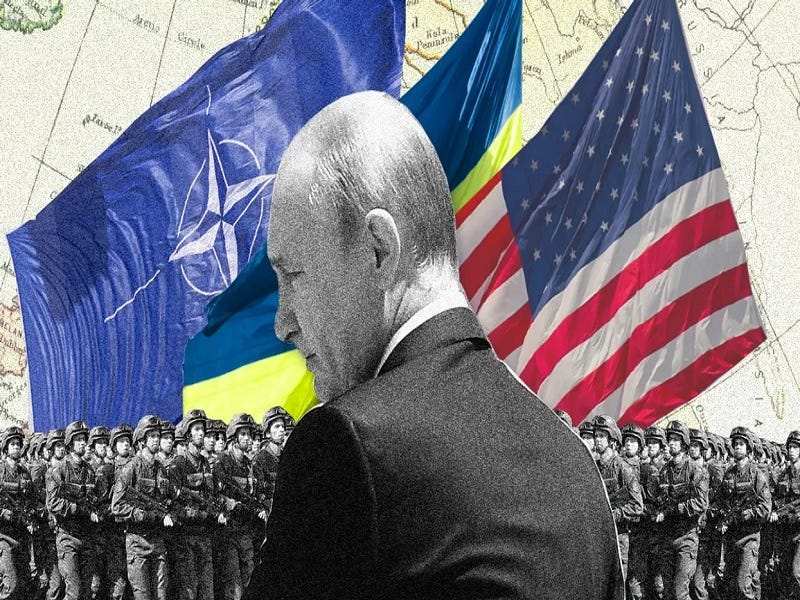NATO might be willing to test Putin’s patience by crossing yet another of Russia’s perceived red lines in spite of its updated nuclear doctrine and new Oreshniks.
The NATO-Russian proxy war in Ukraine might be on the brink of an unprecedented escalation that could easily spiral out of control if Russia’s Foreign Intelligence Service (SVR) is correct in claiming that NATO is planning a 100,000-strong military intervention in Ukraine under the guise of peacekeepers. The purpose is to freeze the conflict, presumably by having these troops function as tripwires for deterring a Russian attack that could spark World War III, and then rebuild Ukraine’s military-industrial complex (MIC).
SVR revealed that Poland will have control over Western Ukraine (like it did during the interwar period); Romania will be responsible for the Black Sea coast (which it seized during World War II via and ruled as the “Transnistria Governorate”); the UK will lord over Kiev and the north; while Germany will deploy its forces to the center and east of the country. The latter’s Rhinemetall will lead the efforts to rebuild Ukraine’s MIC by investing heavily, dispatching specialists, and providing high-performance equipment.
Another important detail is that “NATO is already deploying training centers in Ukraine, through which it is planned to drag at least a million mobilized Ukrainians”, while police functions will be carried out via Ukrainian nationalists that SVR likens to World War II-era Sonderkommandos. The last part is intriguing since it raises the question of why 100,000 NATO troops/peacekeepers would be required. Only a fraction of that is needed for tripwire and training purposes so perhaps those numbers are inaccurate.
In any case, this latest move isn’t surprising, and readers can review the following analyses to learn why:
- * 1 November: “Trump 2.0 would be no easy ride for Vladimir Putin”
- * 7 November: “Here’s What Trump’s Peace Plan Might Look Like & Why Russia Might Agree To It”
- * 8 November: “View from Moscow: Russia tepidly welcomes Trump’s return”
- * 9 November: “The Clock Is Ticking For Russia To Achieve Its Maximum Goals In The Ukrainian Conflict”
- * 10 November: “10 Obstacles To Trump’s Reported Plan For Western/NATO Peacekeepers In Ukraine”
- * 11 November: “Five Reasons Why Trump Should Revive The Draft Russian-Ukrainian Peace Treaty”
- * 15 November: “Trump Probably Really Does Appreciate Two Points From Zelensky’s ‘Victory Plan’”
- * 18 November: “The Moment Of Truth: How Will Russia Respond To Ukraine’s Use Of Western Long-Range Missiles?”
- * 20 November: “Russia’s Updated Nuke Doctrine Aims To Deter Unacceptable Provocations From NATO”
- * 22 November: “Putin Is Finally Climbing The Escalation Ladder”
The last analysis also includes a map at the end depicting the most realistic best-case scenario for Russia.
To summarize, Biden is beating Trump to the punch by “escalating to de-escalate” on better terms for the US, which Russia’s updated nuclear doctrine and the historic first use of the MIRV-capable Oreshnik hypersonic medium-range missile in combat are meant to deter. The 10 obstacles described above still stand, however, so it’s unclear exactly how viable NATO’s reportedly planned conventional intervention in Ukraine (regardless of the numbers involved and the pretext relied upon for justifying it) actually is.
Nevertheless, the fact that SVR warned the world about it suggests that it’s no longer the far-fetched scenario that it was thought to be, though the clock is also now ticking for NATO too since the possible rise to power of a populist conservative-nationalist in Romania next month could spoil these plans. NATO might therefore intervene before 21 December when that figure will take office if he wins. If he loses, then they might bide their time to prepare better, possibly placing this responsibility on Trump’s lap.
At any rate, SVR’s claim that NATO is setting up training centers in Ukraine shows that the bloc is still expanding there. If Russia doesn’t target these facilities, which could spark World War III, then it might have to accept as a fait accompli what SVR just warned about. In that event, as proposed in the “escalation ladder” analysis above, Russia might then reach a deal allowing NATO to safely enter Ukraine up to the Dnieper if Ukraine first demilitarizes everything east of it and north of Russia’s new regions.






